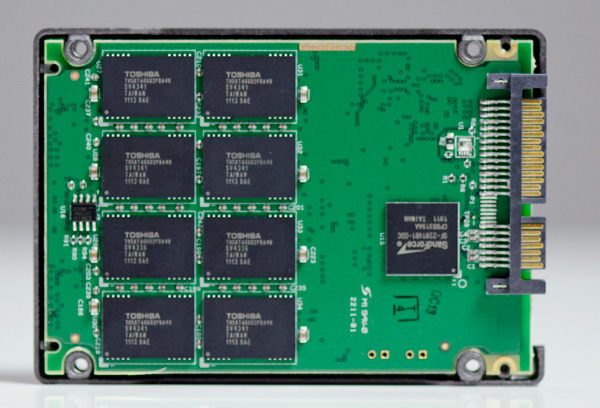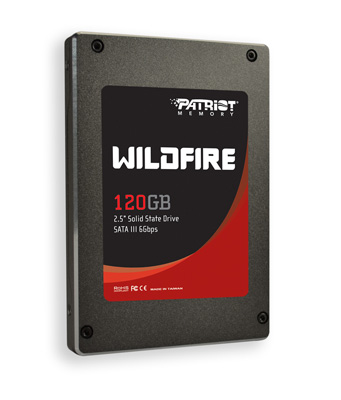OCZ Vertex 3 MAX IOPS & Patriot Wildfire SSDs Reviewed
by Anand Lal Shimpi on June 23, 2011 4:35 AM ESTPatriot's Wildfire
OCZ isn't the only company experimenting with SF-2281 drives and 32nm NAND. Patriot sent me the Wildfire, its first SF-2281 SSD. After a quick run through some performance tests I grew suspicious as it performed a lot like the Vertex 3 MAX IOPS I just tested. Cracking open the case I found the reason:
The Wildfire also uses 32nm Toshiba NAND. The 120GB drive Patriot sent has a 16 chip, 2 die per package configuration - compared to 8 chips with 4 die per package in the Vertex 3 MI. I don't see an advantage for one approach vs. the other. Patriot is targeting a $299 MSRP for the Wildfire, which would put it lower than the Vertex 3 MAX IOPS - although anything is possible once the drive goes on sale on the 28th of this month.

Patriot confirmed that the Wildfire would only use 32nm Toshiba NAND and that any NAND vendor changes would take place in other lines or subsets of the Wildfire brand.
Patriot uses a different PCB layout from OCZ. I don't know that there's an advantage to either layout, they are just different.
The unit I have here shipped with SF firmware revision 3.19, which is equivalent to OCZ's revision 2.08 firmware as far as I know. No word on when we'll see a 2.09 equivalent.
Performance of the Wildfire (as you'll see from the tests that follow) is identical to the Vertex 3 MAX IOPS. To keep the charts more manageable I've only included 6Gbps results from the Wildfire in most areas. Performance on a 3Gbps interface is identical to a 3Gbps Vertex 3 MAX IOPS as you'd expect.
The Test
| CPU | Intel Core i7 965 running at 3.2GHz (Turbo & EIST Disabled) Intel Core i7 2600K running at 3.4GHz (Turbo & EIST Disabled) - for AT SB 2011, AS SSD & ATTO |
| Motherboard: | Intel DX58SO (Intel X58) Intel H67 Motherboard |
| Chipset: | Intel X58 + Marvell SATA 6Gbps PCIe Intel H67 |
| Chipset Drivers: | Intel 9.1.1.1015 + Intel IMSM 8.9 Intel 9.1.1.1015 + Intel RST 10.2 |
| Memory: | Qimonda DDR3-1333 4 x 1GB (7-7-7-20) |
| Video Card: | eVGA GeForce GTX 285 |
| Video Drivers: | NVIDIA ForceWare 190.38 64-bit |
| Desktop Resolution: | 1920 x 1200 |
| OS: | Windows 7 x64 |












112 Comments
View All Comments
DrBungle - Tuesday, August 2, 2011 - link
My config;Asus G73
Core i7 2630
8GB RAM
Shipped with 2 X 500GB 7200PRM HDDs
I pulled the OS drive and replaced it with a Vertex 3. I had stutter issues for the first couple days, that was corrected with 2.09 firmware.
Since then, I've had over 2 months of problem free computing. Large file transfers, extractions, transcodings and countless hours of Bad Company 2 (in preparation for BF3) with not ONE BSoD or even mild hiccup.
Am I the only person in the universe who really likes this drive?
It simply can't be that my notebook computer is somehow magically circumventing some critical flaw with this drive. The term "PEBCAK" comes to mind with a lot of the complaints I hear.
RTFM. (Read The Forums Man). If you want plug and play simplicity, stick with HDDs. Personally, I like a new challenge every now and then but my Vertex 3 certainly wasn't one of them.
umesh - Tuesday, February 28, 2012 - link
In the PC Mark Vantage tests, why is there no trace of the OCZ Vertex 3 240 GB Max IOPS drive at all? Was it not tested or what? Please enlighten me.